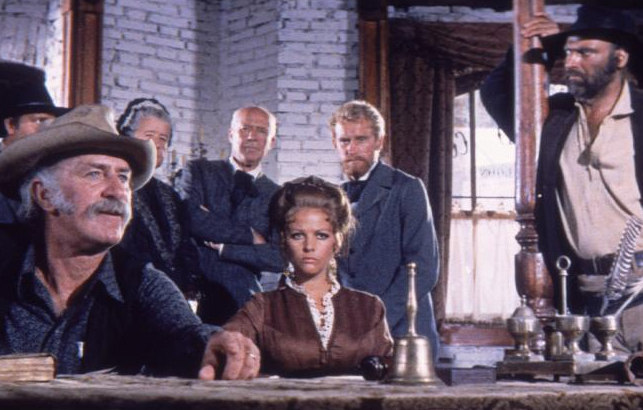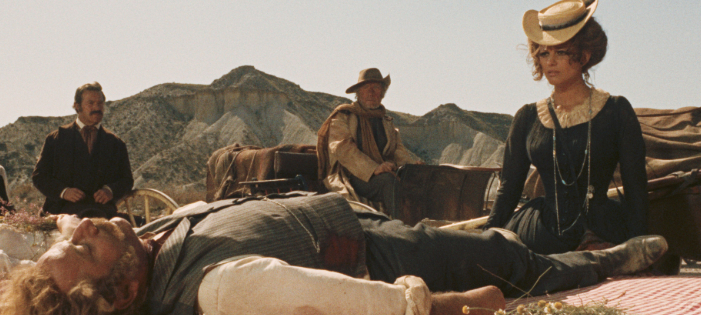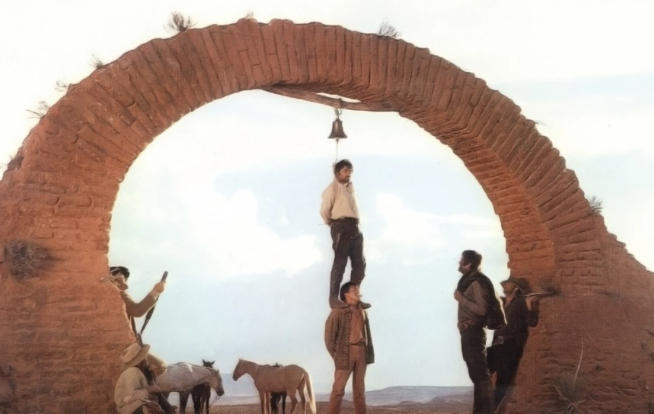Once Upon a Time in the West (1968)
“There were three men in her life. One to love her. One to kill her. And one to watch.”
🏜️ Introduction: The Death of the West, the Birth of Legend
Sergio Leone’s Once Upon a Time in the West is not just a Western — it’s the Western that mourns its own genre. Released in 1968, as the golden age of the American frontier film was drawing to a close, this epic stands as a requiem: brutal, operatic, and filled with the slow, tragic grandeur of a world vanishing before our eyes.
Crafted by the Italian master of the Spaghetti Western and featuring a transatlantic cast led by Henry Fonda, Charles Bronson, Claudia Cardinale, and Jason Robards, this is a film that reshapes archetypes, weaponizes silence, and turns dust, wind, and sound into poetry.
🎞️ Plot: A Woman, a Railroad, and Four Deadly Fates
The story is deceptively simple. Jill McBain (Claudia Cardinale), a former prostitute from New Orleans, arrives in the desolate frontier to start a new life with her new husband — only to find him and his children slaughtered. The land they owned, a patch of worthless desert, turns out to be a goldmine of opportunity: it lies directly in the path of the railroad, the artery of modern America.
Three men orbit Jill’s fate:
- Frank (Henry Fonda): a ruthless killer with ice in his veins — Fonda’s casting, subverting his usual heroic image, is a stroke of genius.
- Cheyenne (Jason Robards): an outlaw with a code and a crooked smile.
- Harmonica (Charles Bronson): a nameless gunslinger with a death-haunted past and a mission of vengeance.
Their paths converge in a mythic collision of greed, progress, memory, and revenge. But it is Jill, not the men, who represents the future — the one who survives, who endures.
🎭 Performances: Silence Speaks Loudest
Charles Bronson, as Harmonica, barely speaks. Yet every movement, every narrowed eye, is filled with purpose. He doesn’t act — he haunts. The harmonica he carries is a sound from his past and a harbinger of death.
Henry Fonda, cast against type, is chilling. His Frank is precise, predatory, and terrifying in his calmness. His blue eyes — once symbols of decency — now pierce with menace.
Jason Robards provides balance, playing Cheyenne with unexpected charm and warmth. He’s rough, rakish, and possibly the most emotionally resonant character.

But the heart of the film belongs to Claudia Cardinale. Jill is not a passive damsel — she is a survivor, a builder, a woman in a man’s world who plays by their rules and ultimately rewrites them. Cardinale gives her depth, strength, and silent sadness that elevates her beyond any traditional Western female lead.
🎥 Leone’s Direction: Time as a Weapon
Sergio Leone turns every scene into a symphony of tension. He holds on faces for what feels like an eternity. He lets windmills creak, dust swirl, and boots echo across stone before a single line is spoken. Dialogue is rare. Glances are loaded. Leone makes you wait — and then when the violence erupts, it is swift, shocking, and mythic.
He stages violence not as spectacle but as consequence. Every gunshot is the punctuation to a long, trembling silence. Every duel is a showdown between destiny and will.

🎼 Ennio Morricone’s Score: Music as Character
Few films in history owe so much to their score. Ennio Morricone, at the height of his power, creates not background music — but a symphonic character that tells its own story. Each main figure has a distinct leitmotif:
- Harmonica’s ghostly instrument, stretched into notes of dread.
- Jill’s theme, lush and mournful, evoking lost innocence and enduring hope.
- Cheyenne’s playful banjo melody.
- Frank’s ominous, descending motifs of death.
This is a soundtrack that doesn’t accompany the film — it inhabits it.

🧠 Themes: Endings, Industry, and the Eternal Woman
Once Upon a Time in the West is not about cowboys or shootouts. It’s about the death of an era.
- The railroad, symbol of progress, cuts through not just land but legacy.
- The frontier, once a place of freedom and violence, becomes commodified.
- The myth of the lone gunslinger collapses under the weight of time.
- Jill, the woman, emerges as the only figure who can build — who represents continuity.
Leone isn’t celebrating the West. He’s eulogizing it.
📊 Final Verdict
Once Upon a Time in the West is more than a Western — it is cinematic opera. Every frame is a painting. Every moment, a meditation. It is slow, yes — intentionally so — because it wants you to feel time, hear the silence, and witness the death of legends.
It is, simply put, one of the most beautiful and important films ever made.
Rating: 10/10
“A bullet fired in slow motion at the heart of the American myth.”
#OnceUponATimeInTheWest #SergioLeone #EnnioMorricone #SpaghettiWestern #CharlesBronson #HenryFonda #ClaudiaCardinale #WesternMasterpiece #CinemaHistory #EpicWestern
